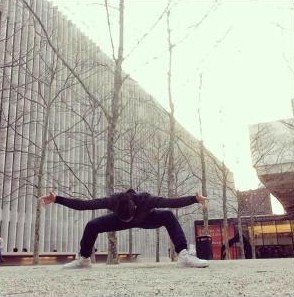| Back to Back Issues Page | |||
 |
|||
|
Dance training today. The Dance Thinker, Issue #29 August 07, 2017 |
|||
The Dance Thinker Issue # 29, August 7, 2017
We have some great new pages: 1. The FAQ (frequently asked questions) page. It’s a great... 2. I wrote a new page about ideas for dance composition... 3. I have continued the task of translating some of our main pages to Spanish. This time is the turn for ...
THE DANCER'S TRAINING TODAY
https://www.contemporary-dance.org/The_Dance_Thinker-dance-training-today.html
We have: - A page for contemporary dance announcements in which you can post your news about workshops, auditions, performances, meetings or any current, related items. - A contemporary dance blog where you can find current information and that will automatically distribute what you post in the announcements page to facebook, twitter and all subscribers to the site’s RSS feed. - A worldwide contemporary dance directory of schools, companies, scholarships, festivals and related websites to which you can also submit your contact information. - A forum for asking dance questions. - Several pages in which you can participate with contributions like articles, reviews, questions, or comments. - An archive for THE DANCE THINKER back issues, where you can always revisit precedent issues from our e-zine. - A contact page through which you can address me directly if you have questions, ideas, wishes, suggestions or comments.
We have some great new pages: 1. The FAQ (frequently asked questions) page. It’s a great release for me, because really… there are some questions that are soooo frequent. The #1 FAQ is this one: Is it too late for me to start dancing? Now we have good, long explanations there, with links to some related chats in the forum. This should be useful for many now. If you’re curious about what the questions are, just visit the page. There are seven FAQ at the moment, with their corresponding replies.
If you want to see all the pages that have been translated to Spanish, visit our sitemap and scroll down till that section. You’ll read: SPANISH/CONTENIDO EN ESPAÑOL. We have around ten pages in Spanish by now: Sitemap of contemporary-dance.org
Just as the question about contemporary dance’s choreographic vocabulary (I keep receiving questions like: … what are the basic steps in contemporary dance?), the question about how to prepare yourself for contemporary dance, demands an ‘explaining type’ response. To construct an answer to this, I decided to interview three of my contemporary dance colleagues. They are all active dancers and teachers and very generously talked to me about these same four questions: 1. How would you describe the contemporary dance class that you teach? 2. Is there any technique or method (from those that have a recognized name or recognized choreographic vocabulary) that is present in the class you teach? 3. How do you think our dancers are training themselves today? 4. How do you think that our dancers should train themselves today? This is what they told us:
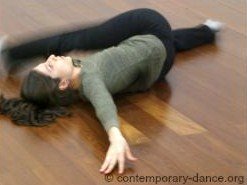 1. My classes are made up of technical exercises, exercises for bodily consciousness, individual and/or group improvisations and physical workout. The specific interest of these classes is to build thinking dancers that are conscious of their bodies, creative and with a critical attitude.
I use two methods to approach the different contents of the class: the first one is made up of exercises that I create and transmit to the students. The second one is made up of guidelines for improvisation or composition, which the students develop individually or in groups. This allows the students to get in contact with the information both from an external proposal and from an internal idea, conceived by them. In this way, we find ourselves in a constant flow between learning and incorporating new tools, and applying them from what each dancer is, with her/his body, mind content and capacities. This is how I search to simultaneously work with the tools of contemporary dance and the
autonomy, creativity and interpretative skills of each dancer.
1. My classes are made up of technical exercises, exercises for bodily consciousness, individual and/or group improvisations and physical workout. The specific interest of these classes is to build thinking dancers that are conscious of their bodies, creative and with a critical attitude.
I use two methods to approach the different contents of the class: the first one is made up of exercises that I create and transmit to the students. The second one is made up of guidelines for improvisation or composition, which the students develop individually or in groups. This allows the students to get in contact with the information both from an external proposal and from an internal idea, conceived by them. In this way, we find ourselves in a constant flow between learning and incorporating new tools, and applying them from what each dancer is, with her/his body, mind content and capacities. This is how I search to simultaneously work with the tools of contemporary dance and the
autonomy, creativity and interpretative skills of each dancer.
2. More than talking about an existing method that I transmit, I should mention the techniques that have influenced me during my educational process and that have allowed me to create what I consider today as my choreographic language. Thanks to my education as a Laban kinetographer, my way of approaching dance is very much from a spatial perspective, precise and concentrated in details and dynamic variations of movement. Also, techniques like Flying Low and Passing Through from David Zambrano and the technique called GAGA from Ohad Naharin, provoked new mind contents and bodily explorations in me, as well as the application of the technique with alternative purposes. In my initial education, there was also great influence of the Cunningham technique, movement analysis and the somatic techniques, especially Feldenkrais, Bartenieff and BMC. 3. In our local context, the majority of times we call ‘contemporary dance’ to techniques that, from my point of view, don’t correspond to this trend. This is why, in many cases, teaching and learning are practiced with methodologies that are based only on imitating, inducing the dancer to reproduce, without necessarily knowing what s/he is doing, why s/he is doing it or what is it going to be useful for. There’s still a search for shape and virtuosity and not for experiencing movement and giving it and interpretative value. 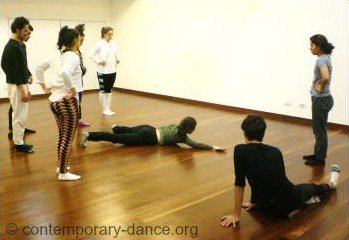 4. I personally believe that the dancer’s training should include not only an important physical work, but also a significant intellectual education about art in general, philosophy and, I’d dare saying, politics. In this way, there would be artists with a defined vision of the world and subsequently with something to say and express through their art, which is dance. In this way, the dancer would be educating her/himself with the goal of creating a body that is useful to transmit what s/he has to say and not only an aesthetical, technical or virtuous goal.
Regarding the bodily training, I believe that this one should consist of many different sources of information: somatic practices, anatomy, movement analysis, and techniques that include coordination, musicality, the relationship with space, with the floor, with the other/the group, and between the parts of the body, movement dynamics (Effort), improvisation and composition.
4. I personally believe that the dancer’s training should include not only an important physical work, but also a significant intellectual education about art in general, philosophy and, I’d dare saying, politics. In this way, there would be artists with a defined vision of the world and subsequently with something to say and express through their art, which is dance. In this way, the dancer would be educating her/himself with the goal of creating a body that is useful to transmit what s/he has to say and not only an aesthetical, technical or virtuous goal.
Regarding the bodily training, I believe that this one should consist of many different sources of information: somatic practices, anatomy, movement analysis, and techniques that include coordination, musicality, the relationship with space, with the floor, with the other/the group, and between the parts of the body, movement dynamics (Effort), improvisation and composition.
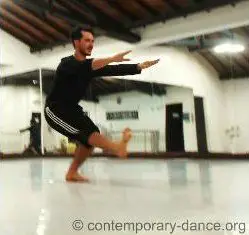 1. In my classes, I share a way in which I train myself, which is a compilation of the work that I’ve done and of what I’ve learned in my path through the field of movement. I organize the class in several stages. In the first stage we make a work with imagination and breath, and about consciousness. It aims to get ourselves ready for movement. Then, I do some work that goes more into space, together with alignment and proprioception work; it also includes more ‘will’ into the work and a more muscular or physical preparation for movement at another level, like with more exertion. At that moment, we make an improvisational work, which sometimes is a solo work and sometimes is a group work, in different levels of improvisation. And then we make a work with movement sequences, which are sometimes proposed by me, but I am also implementing the option of each person constructing her/his own sequences. Then we may do a work of decomposing those sequences and we start working with a
partner to compose in space; sometimes, for example, I may take the sequence of someone and add my own sequence and the one of a previous class, and we put them in space in different ways; that helps us play, and go beyond my own movement and combine one with another; it takes it to a more social level.
1. In my classes, I share a way in which I train myself, which is a compilation of the work that I’ve done and of what I’ve learned in my path through the field of movement. I organize the class in several stages. In the first stage we make a work with imagination and breath, and about consciousness. It aims to get ourselves ready for movement. Then, I do some work that goes more into space, together with alignment and proprioception work; it also includes more ‘will’ into the work and a more muscular or physical preparation for movement at another level, like with more exertion. At that moment, we make an improvisational work, which sometimes is a solo work and sometimes is a group work, in different levels of improvisation. And then we make a work with movement sequences, which are sometimes proposed by me, but I am also implementing the option of each person constructing her/his own sequences. Then we may do a work of decomposing those sequences and we start working with a
partner to compose in space; sometimes, for example, I may take the sequence of someone and add my own sequence and the one of a previous class, and we put them in space in different ways; that helps us play, and go beyond my own movement and combine one with another; it takes it to a more social level.
2. There’s not a specific technique in which we are deepening or that we are trying to develop in the class, but there’s influence of different techniques that I’ve practiced. There’s for example something about Feldenkrais, Euthony, Flying low, a lot of floor work (what a lot of people have decided to name just ‘floor work’) and some acrobatics. But the work is not organized with the goal of developing any of these techniques. There’s also influence that comes from other stage languages; for example we may develop movement towards ‘action’, which takes us into the field o f theater and other important authors or techniques, like for example the improvisation techniques of Layton or Johnstone. David Zambrano’s and Julie Hamilton’s are techniques that have interested me and they are inevitably somehow within what we are studying. But we are not studying one unique technique and it is not about a mixture of them neither. I just see that it all has an influence in my self. I’m making my own personal interpretation and proposing a way to train. I’m not developing a technique or a language either, but I create a conceptual frame and propose something concrete.
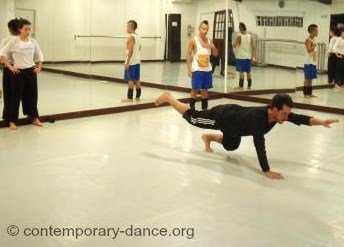 3. If we look at contemporary dance history, we see that around the middle of the past century, and with the widening of the spectrum of what contemporary dance is, the possibility of implementing other training techniques opens because the stage allows the use of those other languages or techniques. So, the big trend that I understand dancers are using today as training is like recurring to various techniques, because the creative language allows it. If you give it names, it can be hip hop, acrobatic gymnastics, and popular dances like flamenco, tango, urban dances, break dance, popping, or the so called somatic techniques: Alexander, Feldenkrais, Euthony, and all these more ‘soft’ techniques.
3. If we look at contemporary dance history, we see that around the middle of the past century, and with the widening of the spectrum of what contemporary dance is, the possibility of implementing other training techniques opens because the stage allows the use of those other languages or techniques. So, the big trend that I understand dancers are using today as training is like recurring to various techniques, because the creative language allows it. If you give it names, it can be hip hop, acrobatic gymnastics, and popular dances like flamenco, tango, urban dances, break dance, popping, or the so called somatic techniques: Alexander, Feldenkrais, Euthony, and all these more ‘soft’ techniques.
4. The question is complicated because that has to do with each one’s interest. To define what contemporary is today and how the dancer’s training should be is still very risky. That’s a question that I have too and because of which I’m opening a space for dancers to train. It’s not about coming to me and establishing that I teach a master class or so. No. I propose a way of training in which dancers can discover another way of training.
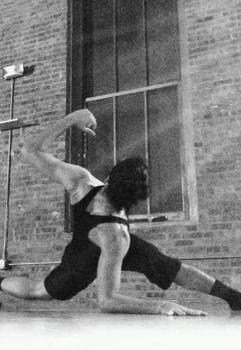 1. I teach in two different contexts. Within the frame of formal studies at the University of Antioquia, the core of the course is an invitation to the students as performers on stage. So, the activities that I develop are an invitation for them to discover themselves as performers. I divide the whole course in four moments. In a first moment we work a lot over the topic of space and its different possibilities, including time and fluidity; we use a choreographic phrase as a pretext, with the idea that they explore around it and then create a duo. We have a second moment, with a second phrase, to work over the topic of weight. In that moment we work over travelling, managing the other’s weight, some contact, including ‘from skin to bone work’, and doing some work of bodily recognition. Using this second choreographic phrase, we construct a second duo, all about giving and receiving weight, pulling and pushing, etc. A third moment is about putting together the two previous
works, to construct a short piece and adding it a conceptualization; it may be an association to a story, a phrase or an idea. The fourth moment is about bringing the choreography to the stage, including all the stage complements, like costumes, make up, lighting, props, scenery, etc. The whole thing is spread along a course of four months. At the end of the stages there’s an accumulation of moments and explorations to arrive to a product for the stage.
1. I teach in two different contexts. Within the frame of formal studies at the University of Antioquia, the core of the course is an invitation to the students as performers on stage. So, the activities that I develop are an invitation for them to discover themselves as performers. I divide the whole course in four moments. In a first moment we work a lot over the topic of space and its different possibilities, including time and fluidity; we use a choreographic phrase as a pretext, with the idea that they explore around it and then create a duo. We have a second moment, with a second phrase, to work over the topic of weight. In that moment we work over travelling, managing the other’s weight, some contact, including ‘from skin to bone work’, and doing some work of bodily recognition. Using this second choreographic phrase, we construct a second duo, all about giving and receiving weight, pulling and pushing, etc. A third moment is about putting together the two previous
works, to construct a short piece and adding it a conceptualization; it may be an association to a story, a phrase or an idea. The fourth moment is about bringing the choreography to the stage, including all the stage complements, like costumes, make up, lighting, props, scenery, etc. The whole thing is spread along a course of four months. At the end of the stages there’s an accumulation of moments and explorations to arrive to a product for the stage.
When I teach in H3 (my company), the process is different. There, we develop different strategies with the goal of finding a language that identifies us as a company. That’s something that takes time. We have been exploring with different guidelines, like contact related things, floor work, or so. We haven’t had a defined timing for things, but we have dedicated time to explore interests that we’ve had. That has allowed us, after some six years, to identify what our main interest is and where do we want to move on to. I feel that we are in a moment now where we have something and in the next two years, we will be clearing up that particular language of the company. Our main interest now is functionality; how is the body functional, on stage and as a performer. 2. There are some techniques that I’ve used more, like floor work, ‘piso móvil’ and Flying low - Passing Through. Other techniques that I use are the Müller technique, which derives from the Limón Technique and I had the opportunity to know in Argentina; the Simonson Technique, which I knew in New York; and contact improvisation. 3. Thanks to the possibility that I’ve had of meeting dancers from various countries, I believe that the trend is to search for more complete human beings. There are no frontiers created by specific techniques, at least for contemporary dance performers; everything becomes like a big amount of information and vocabulary that allows you to use what you need or what better works for what you want to do. So, there’s a search for education in other disciplines as well; there may be gymnastics, martial arts, theatrical techniques, etc., all of which allows the dancer to have more options as a performer. The urban trend is especially strong now. I had the opportunity to see in Los Angeles and New York that contemporary dancers take that information and integrate it with their contemporary dance background. They generate a very interesting proposal by doing that. 4. For me, a contemporary dance performer should have the widest amount of information and vocabulary as possible; not only in movement techniques, but also in acting techniques. That opens a wide range of options as dancer, stage performer or even human being. The contemporary dance training should be something wide and in all senses, including visual arts, theatrical arts, movement arts and all the complementary languages and stage techniques. All of this should be accompanied by an intention of knowing or finding further, because that’s what allows contemporary dance to continue to be ‘contemporary’: corresponding with its environment.
I’d say that these three chats have given me a clear idea. As you may see, each one has its individual approach, but yet they share some kind of same spirit. That spirit that one can feel behind their words is part of what contemporary dance is. It has never been easy to define or grasp, but it is there and we all know it. Our art will continue to evolve, and we will continue to try to understand it and keep it alive. If you want to know more about Sara, Juan Guillermo or Andrés, you can visit the following pages: Sara Idárraga: Juan Guillermo Velásquez: Andrés Avendaño:
Remember to feel free to answer this e-mail. Let me know what you think. I’m always opened to comments, suggestions, ideas, wishes...
Editor and Webmaster of contemporary-dance.org
|
|||
| Back to Back Issues Page |
